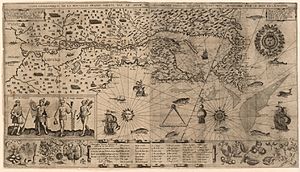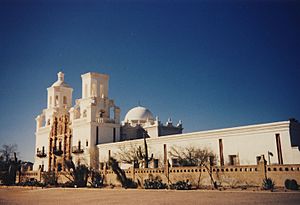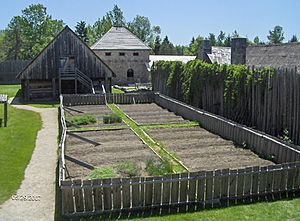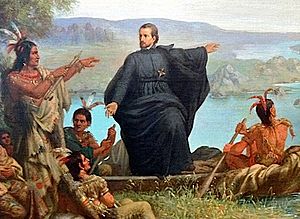Jesuit missions in North America facts for kids

Jesuit missions in North America were efforts by a group of Catholic priests called the Jesuits to spread their faith. These missions started in the late 1500s and became more common in the early 1600s. They were a big part of how France and Spain explored and settled North America. The Jesuits wanted to teach Christianity to the native peoples. They also wrote down many of their experiences in books called The Jesuit Relations.
Contents
Early French and Spanish Missions
Around the late 1500s, Henry IV of France began to think about exploring new lands, including North America.
In 1570, Spanish Jesuits tried to set up a mission in Virginia, called the Ajacán Mission. Sadly, eight missionaries were killed by local Indigenous people in 1571. These missionaries are now known as Servants of God in the Catholic Church.
In 1604, the French explorer Samuel de Champlain began France's important work in North America. He founded Port Royal in 1605, which was the first lasting European settlement north of Florida. He also established Quebec in 1608.
First French Mission (1609)

The Jesuits set up their first mission in Acadia (a French colony) on Penobscot Bay in 1609.
Second French Mission (1611)
The Jesuits were eager to join these new explorations. In 1604, a Jesuit leader named Father Pierre Coton asked for missionaries to be sent to Newfoundland. So, in 1611, the first two Jesuits, Pierre Biard and Enemond Massé, traveled to Port Royal in Acadia. This mission failed in 1613 after an attack by people from Virginia.
Third French Mission (1613)
A third mission was built on Mount Desert Island in 1613.
Fourth French Mission (1625)
The Jesuits planned to move their work to the Saint Lawrence River. A fourth mission began in 1625 with Fathers Charles Lalemant, Enemond Massé, and Jean de Brébeuf, along with assistants. This mission also failed when English forces took over Quebec City in 1629.
Jesuits Settle in North America
Even though Jesuits tried to set up missions in Florida (1566) and Virginia (1571), they didn't truly succeed in North America until 1632. That's when the Jesuit Paul Le Jeune arrived. Between 1632 and 1650, 46 French Jesuits came to North America to preach to Indigenous peoples.
Mission Locations


Missions in New Spain
In the Spanish colony of Viceroyalty of New Spain (which is now Mexico), Jesuits built the first twenty missions in Baja California between 1683 and 1767. These were on the Baja California peninsula.
Also, from 1687 to 1704, Jesuits built twenty-three missions in the Sonoran Desert. This area is now parts of northwestern Mexico and southern Arizona.
In 1767, the Society of Jesus was shut down in the Spanish Empire. This meant the Jesuits had to leave New Spain. Franciscan priests took over their work, building new missions from 1768 to 1822. In Baja California, Dominican priests replaced the Franciscans in 1774.
Missions in New France
In 1634, Jesuits started a mission in Huron territory, led by Jean de Brébeuf. The Mission de Sainte-Marie was very successful and was called "the jewel of the Jesuit mission in New France." However, it was destroyed by the Iroquois, who were enemies of the Huron, in 1648 and 1649. The Jesuits were killed along with many Huron people. Eight Jesuits, who died between 1642 and 1649, are known as the North American Martyrs.
In 1654, Jesuits began missions among the Iroquois. Sainte Marie among the Iroquois (also called Sainte-Marie-de-Ganentaa) was the first, built in 1656 among the Onondagas by Father Simon Le Moyne. Within 13 years, Jesuits had missions among all five Iroquois nations. This happened partly because the French attacked Iroquois villages in what is now New York state. But, because relations between the French and Iroquois were difficult, all these missions were abandoned by 1708. Some Iroquois who became Christian moved to Canada and joined the Jesuit mission village of Kahnawake by 1718.
The Jesuit mission in Detroit moved to Bois Blanc Island in 1742. Later, it was moved closer to Windsor. This Huron mission served both Indigenous people and French settlers. In 1767, it became the Parish of Assumption, the oldest Catholic parish in Ontario.
In the late 1750s, leaders from Kahnawake led 30 families to create a new settlement called Akwesasne, which is now the largest Mohawk settlement in Canada.
Seminaries for Training
To teach young Indigenous people about the Catholic faith, a school called a seminary opened near Quebec, at Notre-Dame-des-Anges in 1636. The first students were five young Hurons, followed by a dozen young Montagnais and Algonquins in 1638–1639. At first, it seemed successful, but the young Indigenous people were not always keen on being educated in this way. Many also became sick and died from diseases brought by Europeans. A second seminary opened in Trois-Rivières but closed after only one year.
Reductions (Settlements)
A more successful idea was to create "reductions." These were villages where local people settled under the guidance of the Jesuits. The reductions in North America were inspired by similar ones in South America, especially in Paraguay. Reductions were first made for the nomadic peoples of the St. Lawrence River valley, like at Sillery near Québec. Later, they were made for settled groups like the Huron-Wendat at Notre-Dame-de-Foy and Lorette, and the Iroquois at La Prairie de la Madeleine.
One famous reduction was Sillery near Quebec, which started with money from Noël Brûlart de Sillery in 1637. By 1645, 167 Indigenous people lived there. The Iroquois attacked Sillery in 1646. In 1670, a measles outbreak hit Sillery, and the Montagnais and Algonquins left the area. By 1698, the Jesuits stopped their missionary work there and gave the land to a local church.
Conflicts with the Iroquois
The Jesuits' work in North America was often made difficult by the ongoing conflicts between the French and the Iroquois. The Huron Nation was greatly weakened by wars with the Iroquois, especially after many died from epidemic diseases between 1634 and 1640. Finally, in 1701, a peace treaty called the "Grande Paix de Montréal" ended the conflict.
The Jesuits encouraged Iroquois who became Christian to change their political views, which sometimes caused problems with those who kept their traditional beliefs. These differences led to conflicts, and sometimes traditionalist Iroquois attacked Christian converts.
Jesuit Methods
The Jesuits in America often used methods that respected the traditional ways of Indigenous peoples more than other European groups. For example, the Puritans in New England often demanded that Indigenous people change their clothes and behavior. A historian named Francis Parkman once wrote that "Spanish civilization crushed the Indian; English civilization scorned and neglected him; French civilization embraced and cherished him." This was a simple way of describing the different approaches.
Jesuit missionaries learned Indigenous languages and tried to understand their customs, especially when living among them. They tried to find similarities between Catholicism and Indigenous practices. They used things like pictures, bells, incense, and candlelight to connect with the spiritual side of Catholicism. They also gave out religious medals and promoted the use of relics.
Sometimes, Jesuits used the idea of Hell to encourage conversion, telling people they would suffer if they didn't become Catholic. For example, Father Paul Le Jeune, who arrived in Iroquois land in 1632, believed that Indigenous people would slowly give up their "evil customs."
In New Mexico, Spanish Jesuit missionaries did not always prepare for different language groups. Indigenous people were sometimes expected to entertain the missionaries. There were also programs that required Indigenous people to work, which forced them to adopt Spanish ways of life and customs.
Further Expansion of Missions

By 1667, Jesuits had a station near what is now Green Bay, Wisconsin. The Illiniwek people there reportedly asked the French to send a missionary to their homeland. In 1668, Father Jacques Marquette was moved to missions further up the Saint Lawrence River in the western Great Lakes region. He helped start missions at Sault Ste. Marie (Michigan) in 1668, St. Ignace in 1671, and at La Pointe on Lake Superior. In 1673, Marquette and French-Canadian explorer Louis Jolliet traveled down the Mississippi River as far south as the Arkansas River.
In the late 1690s, Jesuits expanded along the middle of the Mississippi River. In 1700, they settled at the mouth of the River des Peres. From 1703, a large Jesuit center was based at Kaskaskia in Illinois country, with Jacques Gravier as the main leader.
Many missionaries created studies or dictionaries of the First Nations and Native American languages they learned. For example, Jacques Gravier made a very detailed Kaskaskia Illinois-French dictionary before he died in 1708. This work has helped the Miami Tribe of Oklahoma in their project to bring their language back to life.
In June 1735, Father Jean-Pierre Aulneau de la Touche became a chaplain and went to Fort St. Charles on Lake of the Woods (now in Ontario, Canada, and Minnesota, United States). He traveled through the Great Lakes with Pierre Gaultier de La Vérendrye, a commander. At that time, Father Aulneau was the westernmost missionary in North America. The next year, Father Aulneau, Jean Baptiste de La Vérendrye, and 19 French-Canadian travelers were sent from Fort St. Charles to Fort Michilimackinac to get supplies. On June 8, 1736, they were all killed by "Prairie Sioux" warriors on a nearby island in Lake of the Woods. This attack was supposedly in revenge because Commander La Vérendrye supplied guns to the Sioux's enemies.
Great Britain took control of Canada and lands east of the Mississippi River in 1763 after the Seven Years' War. In Quebec, they allowed the Jesuits to continue working in First Nations villages.
The Jesuits kept their presence until their order was officially shut down in France. They were expelled from Louisiana in 1763. At that time, 27 Jesuits were working from Quebec to Louisiana. After the Order was brought back by Pope Pius VII in 1814, Jesuits started missionary work again in Louisiana around 1830.
Several Belgian men came to study near Bowie, Maryland, in the early 1820s. They all wanted to be missionaries to Native Americans. Father Pierre-Jean De Smet, who started working in Missouri in 1830, built strong relationships with leaders of many Western tribes, including Sitting Bull, a war chief of the Sioux. Throughout the 1800s, Jesuit priests founded missions and schools among Native tribes in what is now Montana and Idaho.
Some Canadian residential schools, which caused harm to many generations of First Nations children and youth, were run by Jesuits. These schools aimed to make Indigenous children adopt European ways and were connected to gaining their lands. Canadian Ojibwe writer Basil Johnston wrote about his experiences at a Jesuit-run residential school in Ontario in the 1930s, showing how students and their families resisted these changes.
Spanish Jesuit Missions in North America
- Spanish missions in Arizona
- Spanish missions in Baja California
- Spanish missions in the Sonoran Desert
- Suppression of the Society of Jesus – Jesuits were expelled and replaced by the Franciscan mission program.
See also
 In Spanish: Misiones jesuitas en Nueva Francia para niños
In Spanish: Misiones jesuitas en Nueva Francia para niños

